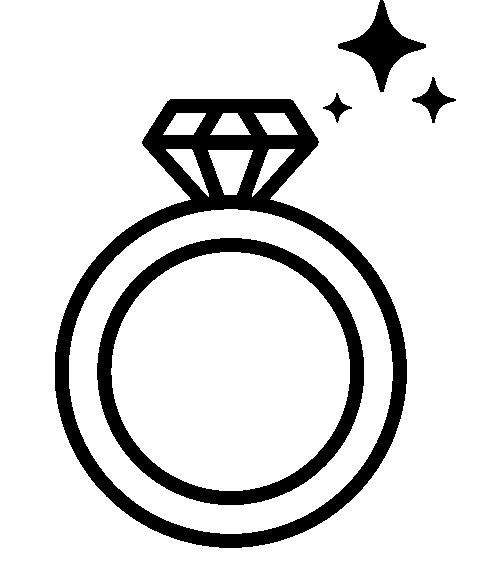
A lot of engagement ring shoppers make the same mistake: they think that the only decision they have to make is choosing the diamond or gemstone they want. This is only the first step! Choosing the perfect band to complement your gemstone centerpiece will make the difference between a beautiful ring and the ideal engagement ring.
These are two favourites when it comes to engagement ring bands: platinum and gold. With many using white gold, which is similar in both hue and colour to platinum, it can become difficult to know which to choose. Here are key elements to consider when choosing between white gold and platinum engagement rings, to guarantee you the perfect diamond engagement ring (or lab grown engagement ring)!
PLATINUM VS. WHITE GOLD ENGAGEMENT RING: A DIFFICULT CHOICE TO MAKE
A BAND THAT COMPLETES THE DIAMOND
Although the diamond is the heart of the engagement ring, there are subtle differences in the visual effect of using white gold or platinum to craft the band. Despite them both being silvery/white in coloration, there are a few key differences that distinguish one from the other. When looking to design a custom engagement ring, it helps to know these differences in advance. This is especially the case if you shop online for engagement rings without the direct in-person advice of an experienced jeweller.
These subtle differences are not only based on looks but also impact the long-term durability of the ring. The different attributes between each metal will serve as helpful tips for picking your engagement ring in the future. Let’s compare platinum vs. white gold to figure out which is best for you and help you find the best engagement ring.
ARE PLATINUM AND WHITE GOLD A DIFFERENT SHADE OF WHITE?
Although these metals both achieve a similar coloration at first glance, the subtle differences in appearance are a result of drastically different composition. Most platinum on the market is almost pure, ranging from 95% to 98% with a small percentage of other metal alloys. The natural colour of platinum is a silvery white, slightly lighter than but comparable to 14 Karat white gold. Although there is a subtle difference in shine, most people would say that they look almost identical at first glance.
14K white gold is actually only 58.3% gold, mixed with varied proportions of nickel, copper and mostly silver to give it more strength as well as a lighter coloration: you will find a color difference between 10 Karat, 14 Karat and 18 Karat white gold. Since a 14-Karat gold ring has a high percentage of gold, which is naturally yellow in coloration, it has a tendency to revert back to a warmer hue over time. It will get darker, sometimes to the point where you can see a yellow tint to it.
Many white gold rings have an additional plating of rhodium to make them look even lighter and shinier. However, even this type of plating will come off over time. Rhodium plating has to be reapplied yearly or every few years depending on its thickness. Conversely, a platinum ring stays white since that’s its natural colour. These subtle differences might make a big impact when choosing between the two.
ARE THERE DIFFERENCES IN STRENGTH & DURABILITY BETWEEN WHITE GOLD AND PLATINUM?
When buying an expensive ring for your significant other, you will look into many things, such as the colour and aesthetics, but also the ring’s durability! We all want a ring that will last a lifetime, and that you will be able to wear every day. When talking about durability, there is a clear winner!
Platinum is the most durable band option for your engagement ring
Platinum is much stronger than any gold alloy. It’s so strong that it’s actually incredibly difficult to cut through in case of emergency! Platinum engagement rings will rarely get damaged in everyday life and, white being its natural colour, it will not lose its appeal as opposed to other alloys. A platinum band will hold your lab grown diamond or gemstone in place for years on end, and will handle scratches as well as the common wear and tear.
This doesn’t mean white gold is a bad option!
White gold, thanks to being an alloy, can be durable and resistant to scratches. Many white gold engagement rings have a rhodium plating that lasts a few years and does a great job protecting the ring from wear and tear.
The rhodium plating added to white gold actually makes it much stronger than yellow gold, though still not as strong as platinum. This not only means the band itself will hold up better to abuse, but also means that platinum rings are much less likely to bend, making it much more difficult for stones to come loose or lost.
IS THERE A DIFFERENCE IN PRICE?
Most people set a max price or a budget when looking for a diamond engagement ring. Whether you’re looking to buy one that’s already made or you’re looking to design a custom engagement ring, the platinum option will always be more expensive.
Why is platinum’s price higher than white gold?
There are two very straight forward reasons why platinum is the most expensive option for your engagement ring band. First of all, platinum is a rare material, meaning there is less platinum in the world and it’s therefore harder to find! This limited supply of the precious metal makes it a more expensive mineral, driving up its price compared to gold.
The second reason is also very simple: platinum is actually heavier than gold. This means that if you were to have the same size, shape and thickness of both a white gold band and platinum band, the platinum rings would always be heavier. This means there always is more platinum in rings of comparably sized bands. Consequently, the price will be higher because you are using more material and the material is more expensive.
LOOKING FOR A HYPOALLERGENIC RING?
It is not uncommon for people to have allergies to metals such as nickel, which is used in many alloys including white gold. While platinum rings are close to completely pure, white gold gets both its white hue and added durability from varying proportions of nickel, copper and silver.
This means that platinum is a safer option than white gold for users whose skin is more sensitive to these metals. But white gold rings can work too, since many of them are coated with a layer of rhodium plating! This added layer prevents direct contact with the wearer’s skin and, as long as it hasn’t worn off, will greatly reduce the chances of an allergic reaction to nickel.
SO, BETWEEN WHITE GOLD AND PLATINUM, WHO IS THE WINNER?
Advantages of platinum
Platinum is more durable, naturally lighter in colour, and mixed with fewer alloys allows – thus ‘purer’, which may have a symbolic meaning to some people. This purity also makes it more hypoallergenic than gold! However, prepare yourself for a price that matches the quality of platinum bands.
Advantages of white gold
White gold is lighter for people who don’t like a heavy ring, but it’s rhodium plating has to be reapplied periodically, though this plating makes it stronger while also removing contact with the allergenic alloys to the skin. The rhodium plating of most white gold bands means it will be more maintenance in the long run, but has a more advantageous price and is slightly shinier.
CLEANING PLATINUM AND WHITE GOLD ENGAGEMENT RINGS
Both types of bands can be cleaned at home by following this simple method:
- Mix dishwashing soap with warm water in a bowl
- Put the rings you would like to clean in the solution and let it soak between 20 and 40 minutes. The time will depend on how dirty the jewels are!
- Rince the ring under warm water. Make sure the plug is closed before you start to avoid dropping the ring in!
- Dry the ring gently with a non-fibrous cloth and it is done!
This method can clean your rings to a certain extent, but will not bring it back to the same shine it had when you bought it. To make it look as good as new, you will need a professional cleaning service. Donj Jewellery offers jewelry repair and cleaning services, where your rings can be cleaned using ultrasonic cleaning technology.
SHOULD YOU CHOOSE PLATINUM OR WHITE GOLD FOR YOUR ENGAGEMENT RING?
The truth is that it all comes down to your personal preferences and your budget! White gold tends to have rhodium plating that fades over time, but is generally cheaper and less durable than platinum. For example, platinum prongs holding the center stone of your engagement ring are less likely to break than white gold ones.
A great way to make sure you are making the right choice is talking with an experienced jeweller. Donj Jewellery’s experts can guide through your decision process, make recommendations based on your budget and preferences, as well as provide you with all the information you need. Buying an engagement ring is an important decision, so make sure it is perfect!





 My Account
My Account  My Bag
My Bag  My Wishlist
My Wishlist 
